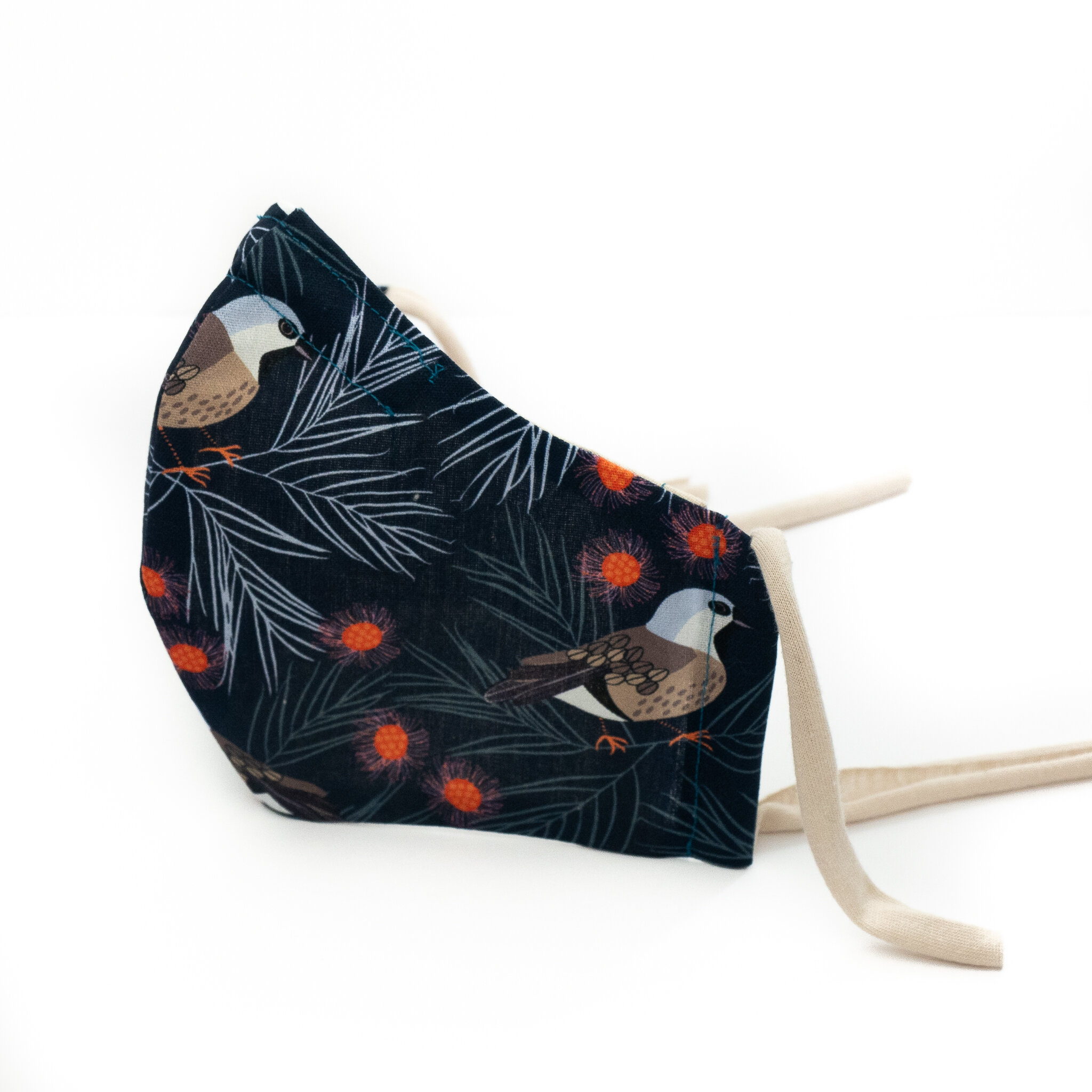What’s in a mask?
I never thought I’d get into sewing by making masks, sewing was something that I’d aspired to master but have always been afraid of it. Maybe because back when I was a teenager I tried my hands on sewing and after one too many disasters (like somehow attaching a sleeve to the back of the shirt!) I had put it firmly on the backburner, thinking one day, maybe, that I would go back to it.
That one day came earlier than I thought. About over a week ago Victorian government made wearing a mask/face covering mandatory while in public, having ordered some cloth masks online and being told that due to the heightened demand my order was going to be significantly delayed, I decided to make my own.
Luckily I had some quilting cotton at home (see I told you it was on the back burner and I was even prepared for it!), so after some initial research and recommendations from friends I’d settled on a 3D mask that looked simple enough, it only had straight lines! But I was overestimated the enthusiasm and underestimated my ability – the first couple were disasters! My seams were all over the place, there were tangled threads everywhere, the fold was right, and the size was too big… oh, and my line was not even straight.
My first attempt…
it was too big :(
I swore, I cursed, and I sacrificed length after length of good fabric to the sewing goddess who, despite my offerings, seemed unmoved. Feeling desperate I dissected a disposable mask and copied the folding and then, as if my prayers had been answered, or perhaps the goddess took pity on me, I made something that was quite good looking, and it fit! I got excited, went to Spotlight (the only fabric store local to me) and bought more fabrics, a cutting board, a quilting ruler, proper scissors and threads; and I made masks for the whole household.
My reverse engineered mask
it worked!
After making about 20 masks I wanted to try different designs and make improvements. I also started reading about what makes a good fabric mask, which materiel is more suitable and provides better protection. There is a vast array of information and some contradict others, many are vague and often downright confusing. I am listing some of the resources below so you can check them out yourself.
While there are no hard and fast rule as to which design makes the best fabric mask, there are recommendations by WHO, government organisations, science bodies and countless blogposts detailing what makes a good mask. So here’s a summary of what I learnt on mask making:
It should have at least 3 layers and one of them polypropylene for filtration: Spunbound non-woven polypropylene (NWPP) not Meltblown
Cotton, especially high density cotton (high thread count) such as quilting cotton or bedsheets, when doubled and combined with a filter can provide better protection
A good fitting mask is a must, there should not be any gaps
Spandex, chiffon, silk and flannel are also good choices for fabric masks, especially in multilayers
It should allow air flow, meaning you should be able to breath easily (no coffee filters or vacuum bags)
A nose wire ensures the top of the mask stay put and minimises gaps
Some elastics are too tight for comfort, t-shirt yarn is a good alternative, or bias tapes
Overhead ties can provide better fit for some people, ear loops should not be too tight nor too loose.
It should be able to be laundered in high temperature (60 degrees Celsius) – I’ve washed mine in the washing machine at 60C and they came out well.
Having kitted out my own household I feel more at ease with the sewing machine. I kept making more masks in different designs and I’ve been making them for friends on request. With the mandatory masks now extended to the whole of Victoria I’m thinking of adding masks to my store, I want to offer reusable masks that will give decent protection afforded by a fabric mask.
I am still a slow sewer but I’m gaining confidence each day – you might say this is the silver lining coming out of the crazy 2020.
a mask made for my store
it has three layers
Have you been making masks? Are there tips you can share with us?
Below are some of the resources I’ve looked at:
Scientific studies:
https://pubs.acs.org/doi/10.1021/acsnano.0c03252?ref=pdf&
https://pubs.acs.org/doi/suppl/10.1021/acsnano.0c03252/suppl_file/nn0c03252_si_001.pdf
WHO:
Other resources :
https://www.cdc.gov/coronavirus/2019-ncov/prevent-getting-sick/about-face-coverings.html
https://makermask.org/the-big-four-criteria-for-community-mask-materials/
https://makermask.org/materials/
https://www.creativemechanisms.com/blog/all-about-polypropylene-pp-plastic
https://smartairfilters.com/en/blog/best-diy-coronavirus-homemade-mask-material-covid/?rel=1
-
March 2023
- 17 Mar 2023 Pain By Numbers - fibre minis 17 Mar 2023
- 11 Mar 2023 Burstling - the making of a pattern and yarn kit 11 Mar 2023
-
January 2023
- 16 Jan 2023 Yarn over Yarn and Kai Fella Sweater 16 Jan 2023
-
October 2022
- 3 Oct 2022 Fibre Focus - Cheviot 3 Oct 2022
-
September 2022
- 11 Sept 2022 A woven scarf and some thoughts on bamboo fibre 11 Sept 2022
-
July 2022
- 31 July 2022 Double Width Weave 31 July 2022
-
November 2021
- 26 Nov 2021 Fibre Arts Friday 26 Nov 2021
- 5 Nov 2021 Fibre Arts Friday - one stitch at a time 5 Nov 2021
-
October 2021
- 29 Oct 2021 Fibre Arts Friday - crafting through crisis 29 Oct 2021
- 22 Oct 2021 Fibre Arts Friday Resurrection 22 Oct 2021
-
November 2020
- 4 Nov 2020 Eucalyptographia homework 4 Nov 2020
-
September 2020
- 24 Sept 2020 Eucalyptus camaldulensis 24 Sept 2020
-
August 2020
- 1 Aug 2020 What’s in a mask? 1 Aug 2020
-
July 2020
- 16 July 2020 The many faces of Khal Drogo 16 July 2020
- 6 July 2020 A tale of “two lochs” 6 July 2020
- 3 July 2020 The Big Wool Show is coming… 3 July 2020



